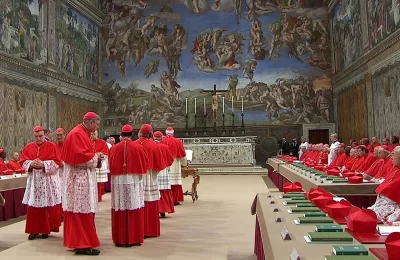Part 3 of Life and the Sanctity of Life
Scripture: 2 Corinthians 5:17
“Therefore if anyone is in Christ, he is a new creation; the old things passed away; behold, new things have come.”– 2 Corinthians 5:17 (LSB)
Up to this point, our series has focused on defending the sanctity of life and building a culture that values life at every stage. But what about those who have already been touched by the tragedy of abortion? Many Christian pro-lifers know someone – a friend, a family member, perhaps themselves – who has an abortion in their past. In the United States, it’s estimated that 1 in 4 women will have an abortion by age 45, and a significant number of men have been involved in those decisions. Within our churches are women (and men) carrying secret wounds and guilt from abortion. The gospel compels us not only to prevent abortion, but also to bring healing and redemption to those impacted by it. This article turns to the redemptive hope we have in Christ for post-abortive individuals. Is there forgiveness for the sin of abortion? Can God truly heal the deep emotional and spiritual scars? The resounding answer of Scripture is YES. We will discuss biblical assurance of forgiveness, theological reflections on God’s grace that covers even the “biggest” sins, and practical steps for finding healing after abortion. We will also share testimonies of grace – stories (real or representative) of women and men who found hope and restoration in Jesus. The tone here is pastoral: where sin has brought devastation, Christ brings new creation . Our aim is to equip Christians to extend Christ’s love to post-abortive individuals without judgment or shaming, and to encourage those individuals that they are not beyond the reach of Christ’s redemption. In doing so, we reflect the heart of our faith: that “where sin increased, grace abounded all the more” (Rom 5:20).
The Gospel of Redemption: No Sin Beyond Grace
At the core of Christianity is the belief in redemption – that through the death and resurrection of Jesus, sinners can be forgiven and made new. This is not abstract theory; it applies to every specific sin, including abortion. While abortion is indeed a serious sin (it is the taking of innocent life), it is not the unforgivable sin. The only unforgivable sin according to Scripture is the persistent rejection of the Holy Spirit’s testimony to Christ (Mark 3:28–30). Any sin, no matter how grievous, can be washed away by the blood of Jesus if one genuinely repents and turns to Him.
Consider 1 John 1:9 (LSB): “If we confess our sins, He is faithful and righteous so that He will forgive us our sins and cleanse us from all unrighteousness.” “All unrighteousness” – that covers abortion, too. King David was guilty of arranging a man’s death (essentially murder) and committing adultery, yet when he humbled himself, he found forgiveness (see Psalm 51, a poignant prayer of repentance). The Apostle Paul was once “a blasphemer and a persecutor and a violent aggressor” of the church (1 Tim 1:13), effectively complicit in murders of Christians (Acts 8:1-3) – yet God’s mercy transformed him into a great apostle. These biblical examples are given “for our instruction”, to show that God’s grace can redeem the worst of pasts. As Paul triumphantly declares: “Christ Jesus came into the world to save sinners, among whom I am foremost” (1 Tim 1:15). If the “chief of sinners” obtained mercy, so can anyone reading this who feels like they are the chief of sinners for having been involved in an abortion.
2 Corinthians 5:17 (cited above) encapsulates the hope of the gospel: in Christ, you truly become a “new creation.” The old record of sin is wiped clean by His atoning sacrifice. “Though your sins are as scarlet, they will be as white as snow”(Isaiah 1:18). For a woman who’s had an abortion, this means that in God’s eyes, through Christ, she does not have to be forever labeled “abortionist” or “murderer.” She becomes a beloved daughter of God, purified and restored. The shame and guilt can be lifted and replaced with joy and peace. The same applies to men who might have pressured a partner into abortion or failed to stand up for their child. In Christ, that man can find forgiveness and a chance to be a protector of life going forward.
It’s important to stress that redemption is holistic: God not only forgives the sin legally, He also works to heal the emotional and psychological wounds. Abortion often leaves deep trauma, even if suppressed for years. One study of post-abortive women found that up to 92% experienced emotional numbness or trauma symptoms within 10 years after their abortion . Many suffer grief, regret, depression, anxiety, nightmares, or anniversary reactions. Some turn to substance abuse or other self-harm as coping mechanisms. These responses may emerge even long after the abortion, as the person may initially feel relief, only to encounter latent sorrow later . The secular world often tries to deny or minimize these effects (claiming “most women feel relief and don’t regret it”), but those of us in ministry have repeatedly encountered women (and men) in deep pain over a past abortion – sometimes decades later. As one counselor noted, “The majority of women we see are usually 15, 20, 30, 40 years removed [from their abortion]” before they seek healing . This tells us that time alone does not heal these wounds; they often fester under the surface.
That’s where the unique grace of Christ comes in. Jesus not only forgave Peter for denying Him but also restored him gently (John 21:15–19). He not only stopped the stoning of the adulterous woman but also gave her dignity back: “Neither do I condemn you; go and sin no more” (John 8:11). Theologically, we understand that on the Cross, Jesus bore all our sin and shame – including the guilt of abortion – and also our sorrows (Isaiah 53:4). Therefore, He is able to carry the emotional burdens and grant true inner healing. Where there is guilt, He provides atonement; where there is shame, He covers it with His honor; where there is grief, He promises comfort (Matt 5:4). “He heals the brokenhearted and binds up their wounds” (Psalm 147:3).
For someone struggling after abortion, one of the hardest parts is forgiving oneself. Even if they intellectually believe God can forgive them, they may feel they can never get over the self-condemnation. This is where the truth of justification by faith is so crucial. Romans 8:1 proclaims: “Therefore there is now no condemnation for those who are in Christ Jesus.”If God – the holy Judge – does not condemn you because Christ was condemned in your place, then you do not have the right to condemn yourself. To continue punishing oneself is in a sense to say Jesus’ punishment on the cross was not enough, which dishonors His sacrifice. Gently help the person see that accepting God’s forgiveness and forgiving oneself go hand in hand. It might be a process, but the word of God assures us that “if our heart condemns us, God is greater than our heart” (1 John 3:20). His verdict of “forgiven and righteous in Christ” overrules our self-accusation.
Another theological question that may trouble post-abortive Christians is: “What happened to my baby’s soul? Can I have hope of seeing them again?” The Bible does not explicitly detail the fate of those who die in infancy or before birth, but many theologians (including perhaps Wayne Grudem and others) believe there is strong evidence of God’s mercy on these little ones. David, after losing his infant son, said, “I shall go to him, but he will not return to me” (2 Sam 12:23), implying a hope of reunion in the afterlife. God’s character – “abounding in lovingkindness” (Ex 34:6) – and Jesus’ special love for children (Matt 19:14) give us reason to trust that these unborn babies are in His care. While we cannot be dogmatic, many grieving mothers find comfort in entrusting their child’s soul to a merciful Savior. In some post-abortion healing programs, women are encouraged to acknowledge and even symbolically name their lost child, entrusting them to God. This can humanize the loss and provide closure. The hope of heaven means that through Christ, reconciliation is possible not only between the sinner and God, but potentially between the mother and child in God’s presence one day. This hope should be offered carefully and sensitively – not to excuse the sin, but to magnify God’s grace. It aligns with God’s promise to “wipe away every tear” (Rev 21:4) in eternity.
The Path of Healing: From Brokenness to Restoration
Healing after abortion is typically a journey, not an instantaneous event. It involves facing the truth, receiving grace, and sometimes walking through grief, but ultimately it leads to freedom. Many churches and ministries offer post-abortion support groups or Bible studies (such as “Surrendering the Secret”, “Forgiven and Set Free”, or retreats like Rachel’s Vineyard). These provide a safe space for women (and men) to process what happened in light of God’s love. If you are ministering to someone hurting from an abortion, here are key components often involved in the healing process:
- Acknowledgment and Repentance: True healing can’t bypass repentance. Suppressed guilt can eat away at the soul. Psalm 32:3 describes David’s state when he kept silent about his sin: “my bones wasted away through my groaning all day long.” But once he confessed, he found relief. Similarly, a post-abortive person often needs to openly acknowledge, “I have sinned; I took a life; it was wrong.” This is painful, but it’s also the door to mercy, for “He who conceals his transgressions will not prosper, but he who confesses and forsakes them will find compassion” (Prov 28:13). God already knows the truth; confession is agreeing with God about it. In a grace-filled environment, a woman can finally say, “I had an abortion,” sometimes for the first time out loud, and then be assured that when we confess, God is faithful to forgive . Along with confession to God, some find it helpful to write a letter to the baby, asking forgiveness – not that the baby can read it, but as an exercise of acknowledging the reality of the life lost. Repentance isn’t about wallowing in shame, but about unburdening the soul at the foot of the Cross and turning one’s heart toward God for help.
- Accepting Forgiveness: After repentance, the critical step is to truly receive God’s forgiveness. This can be a battle as mentioned, because emotions may lag behind the decision of faith. Here, saturating oneself in God’s promisesis key. Verses like Isaiah 1:18, 1 John 1:9, Psalm 103:11-12 (“as far as the east is from the west, so far has He removed our transgressions from us”), and Micah 7:19 (“You will cast all our sins into the depths of the sea”) should be read and prayed over until the truth sinks in. Sometimes a tangible symbol helps – for example, writing “Paid in Full” or “Forgiven” on a piece of paper and burning or shredding it as a symbol that the debt is gone. In some healing retreats, participants nail a piece of paper representing their sins to a wooden cross and leave it there, signifying that Jesus took it. The goal is to move from head knowledge (“I know God can forgive”) to heart knowledge (“I believe God has forgiven me in Christ”). This often restores a sense of peace with God. Many women in post-abortion ministries describe a moment or process where the wave of God’s love finally breaks through their hardened self-hatred and they can weep and feel loved and accepted by Him. That is the miracle of grace. Indeed, former abortion clinic worker Abby Johnson noted, “Trauma doesn’t usually present until 10-15 years post-traumatic event… Those women have NO idea how they will feel many years later.” But when it does surface, it can be an opportunity to turn to God and find His grace waiting.
- Grieving the Loss: Forgiveness does not erase natural sorrow. In fact, part of healing is allowing oneself to grieve the child who was lost. Our culture doesn’t provide a script for grieving an aborted child (there’s no funeral, often no one else acknowledges the loss), so it’s important to create space for this. In Christ, a woman can grieve with hope. She can name what happened – “I lost my baby” – and mourn that death, while knowing she is forgiven. This grief is actually a sign of heart change; as 2 Corinthians 7:10 says, “godly sorrow produces repentance leading to salvation, leaving no regret.” A healthy mourning recognizes the value of the life that was taken, which is consistent with a renewed mind. It’s appropriate to shed tears and even feel anger at the circumstances – perhaps anger at a boyfriend who pressured her, or at the fear that drove her to it. Those emotions need to be processed and then given to God. A memorial service or symbolic act can help: some release balloons or plant a tree in memory of the child. This is not morbid; it’s bringing closure and honoring the reality of the child’s life. The church can gently assist in these rituals if appropriate, or at least give permission to grieve. Matthew 5:4 promises, “Blessed are those who mourn, for they shall be comforted.” We often see that once true mourning happens, the stage is set for comfort and moving forward.
- Accepting Oneself and Sharing the Story: As healing progresses, the individual can start to see themselves not as a “terrible person” but as a redeemed sinner in God’s family. Self-forgiveness (based on God’s forgiveness) gradually replaces self-loathing. The verse “love your neighbor as yourself” implies a proper love for oneself as God’s creation – which includes accepting that if God can still love me after what I’ve done, I can learn to love the person God has remade me to be. This often blossoms into a desire to help others. A striking pattern in post-abortion ministry is that many who find healing become the most powerful advocates of life and ministers of grace. They, better than anyone, can reach another woman who is sitting in shame and say, “I’ve been there, and let me tell you what Jesus did for me.” What Satan intended for evil (destruction and guilt) God can use for good (saving other lives and souls) . There are countless testimonies of former abortion clinic workers or post-abortive mothers who now speak publicly, hold signs saying “I Regret My Abortion” at rallies to encourage others, or volunteer at crisis pregnancy centers, offering compassion rather than judgment. This is often the completion of the healing journey: when the person can talk about their past openly (with discretion) and use it as a ministry. Revelation 12:11 says the saints “overcame [the accuser] by the blood of the Lamb and by the word of their testimony.” When a woman can incorporate her abortion story into her testimony of God’s grace, the enemy loses his power to shame her. She is walking in victory, and her story can lead others to freedom.
Consider a composite testimony that illustrates this journey:
Testimony (Composite): “I was 19 and in college when I became pregnant. Scared and feeling alone, I had an abortion. At first I felt relief, but I soon spiraled into depression. I avoided baby items and cried secretly every year around the due date I had calculated. I started drinking heavily to numb my pain. Years later, after I married, the suppressed guilt resurfaced powerfully when I had difficulty conceiving – I felt it was punishment. By God’s providence, I attended a post-abortion Bible study at a church. For the first time, I admitted out loud, ‘I killed my baby.’ It was so hard, but the other women and leader hugged me and cried with me. Over weeks, I learned about Jesus’s forgiveness. It seemed too good to be true that He could forgive me. But as we read Scriptures, I felt hope glimmer. One night I knelt and sobbed, asking God and my baby to forgive me. In that moment, I sensed God saying, ‘You are forgiven and you are Mine.’ A weight truly lifted. I finally allowed myself to grieve my baby – I named her Sarah – and I wrote a letter to her, which I tucked into my Bible. I have confidence that she’s with Jesus, and one day I’ll see her and tell her I love her. Today, I help lead that same Bible study for other post-abortive women. God turned my mourning into ministry. I still feel sad at times, but no longer in despair – I know I am a new creation in Christ (2 Cor 5:17), and nothing, not even my past abortion, can separate me from His love (Rom 8:38-39).”
This story combines elements of many true stories shared in ministries like Silent No More, where as of a couple years ago over 6,000 women and men have publicly shared their abortion regret testimonies . Hearing such accounts can inspire those still suffering in silence to come forward and seek help.
The Role of the Church: A Safe Haven for Healing
For the church to effectively offer healing, it must be a place of grace and truth in balance. Truth, in that we do not minimize the sinfulness of abortion – honesty about sin opens the way to repentance. But grace, in that we don’t crush the repentant with condemnation or stigmatize them as second-class Christians. Sadly, many post-abortive individuals fear judgment from the church, so they hide their past. We must work intentionally to change that climate. Here are ways the church community can foster healing:
- Preach the Full Counsel of Grace: When pastors teach on abortion (and they should, lovingly), include not only the pro-life ethic but also the message of forgiveness for it. For example, a sermon might say, “Abortion is a sin against God’s gift of life. But if you are here and this is part of your story, know that Jesus’ blood can cover this sin and our church is here to walk with you toward healing.” Such words could be life-saving. It signals to the congregation that yes, we call sin sin, but we also unabashedly proclaim grace bigger than sin. Some churches avoid mentioning abortion at all; others mention it only to condemn it. Neither extreme helps the wounded. Speaking about forgiveness in the same breath as sin takes away Satan’s power to isolate people in shame.
- Confidential Support Groups/Counseling: Churches can either host their own post-abortion recovery groups or partner with local pregnancy centers that offer them. Make these opportunities known (discreetly) through bulletin inserts or the church website. Ensure confidentiality so people feel safe. Trained counselors or peer facilitators (often women who have been through healing themselves) should lead. Having such a group demonstrates the church’s commitment to restoration. Even those who don’t attend will notice that the church acknowledges their hidden pain. For one-on-one counseling, have referral options to Christian counselors skilled in trauma and post-abortion issues.
- Include Men in the Healing Conversation: Often forgotten are the fathers of aborted children. Many men experience regret, guilt, or complicated grief – whether they pushed for the abortion or failed to protect or even if they didn’t know until it was too late. Ministries should invite men to process their pain as well. A man might feel he has no right to grief since it “was her body/her choice,” but he is a father who’s lost a child. Encourage confession and counseling for them too, and stress God’s forgiveness. Some churches have begun men’s post-abortion groups, which is a great development because men’s hearts need healing and accountability to move forward. A healed man can become a defender of life and a loving husband/father in the future, breaking cycles of sin.
- Language and Atmosphere: Church leaders and members should be mindful of how they speak about those who have had abortions. Avoid ever speaking in a way that paints them as monsters. We can call abortion murder in a prophetic sense, but when dealing with individuals we recall that many felt trapped or were misled. We should adopt the stance, “Hate the sin, love the sinner.” It can be powerful when a congregation hears its pastor say, “There is no sin you have done that puts you outside the reach of Christ’s love – not abortion, not anything. We are all sinners in need of grace.” This levels the ground. Also, during times like corporate prayer, include those hurting from past abortions in the petitions, so it’s normalized as something we know exists and we bring to Jesus. For example, “Lord, we pray for women among us who may be silently suffering from a past abortion. Bring them your comfort and courage to seek healing.” These small gestures assure people that if they come forward, they will meet compassion.
- Resource Library: Provide books or pamphlets on post-abortion healing in the church library or resource center. Sometimes someone will pick up literature before they’re ready to talk to a person. Having testimonies or Bible studies available can plant seeds. Likewise, on the church website under “Resources for help,” list post-abortion counseling among offerings. It says, We see you, and help is here.
- Foster a Culture of Testimony: When appropriate, let redeemed voices share their testimonies. If a woman from your congregation has gone through a healing program and is willing, perhaps she can share (in a sensitive setting) about her journey. Hearing a fellow believer say “I had an abortion and Jesus forgave and changed me” can break through so much isolation. It also educates those who’ve never been in that situation to have more compassion rather than quick judgment. It puts a face on the issue – not an abstract “sinner” but Sister So-and-so whom they respect. Many churches have found that once the first brave soul shares her story, others feel safe to seek help. Of course, no one should be pressured to share publicly; it must be Spirit-led. But valuing testimonies of God’s grace for all sins will organically include post-abortion stories over time.
In summary, the church’s role is to embody Christ – full of grace and truth (John 1:14) – for those wounded by abortion. We should be the first to say, “Neither do we condemn you; go and sin no more,” and also to extend a hand to help them walk that out.
Practical Application: Embracing Redemption and Moving Forward
For the individual who has received God’s forgiveness after abortion, what now? Here are some practical encouragements to live in the reality of redemption:
- Rest in Your Identity in Christ: Memorize 2 Corinthians 5:17 and Romans 8:1. When the enemy tries to whisper shame from the past, answer with God’s Word: “I am a new creation; that old me is dead. There is no condemnation for me in Christ Jesus.” It might help to journal identity statements: “I am forgiven. I am washed clean (1 Cor 6:11). I am God’s beloved child (1 John 3:1).” Spiritual growth – through prayer, Bible reading, and fellowship – will reinforce these truths. Regular worship and participation in the sacraments (like communion, where we remember Christ’s blood shed for our sins) also cement the sense of being part of the family of God, no longer alienated.
- Engage in Service (When Ready): Sometimes healing accelerates as you begin to serve others. It might start with something not directly related – like volunteering in the church nursery or helping with a food drive – just to re-integrate and combat the tendency to withdraw. In time, you might feel led to specifically join the pro-life cause or post-abortion ministry, but there’s no rush. Follow God’s lead. When one has been forgiven much, there’s often an overflowing love (Luke 7:47) that can pour out in service. Many women say that mentoring another post-abortive woman was incredibly healing for themselves too, as it reminded them of how far God has brought them. Even simply sharing your testimony anonymously (say, writing it out for a blog or letter) can be cathartic and purposeful.
- Guard Against Triggers and Lies: Healing is a journey, and occasionally certain situations may trigger emotions (like seeing an abortion debate on TV or a certain stage of pregnancy in someone else). Recognize when feelings of anger or sadness resurface. Don’t be alarmed as if you’ve lost your healing; it’s an opportunity to process another layer. Go back to God in prayer whenever pain resurfaces. Have a support person you can call. Also, be aware of Satan’s tactics – he might try to lie, “You’re not really forgiven” or “If people knew, they’d hate you.” Counter those lies with truth: “It is written, the Son has set me free, so I am free indeed” (John 8:36). Over time, triggers will lessen and the lies will weaken as truth reigns.
- If You Haven’t Already, Consider Memorializing Your Child: Some women find they want to do something in memory of the child as a sign that they accept God’s forgiveness and look forward, not with morbid guilt but with love. This could be participating in a communal memorial service for unborn children (some pro-life organizations hold these), or doing something private like lighting a candle on the anniversary and praying, not in despair but entrusting the child to God. This can transform a day that used to be only painful into a moment of hope and prayer. If you feel led, you might also engage in advocacy to prevent other babies from being lost – turning your child’s brief life into a catalyst for saving others.
- Connect with a Community: Stay plugged into a small group or recovery alumni group. As Hebrews 10:25 urges, “do not forsake assembling together…encourage one another.” Having fellow believers who know your journey means you don’t have to face future challenges alone. They can celebrate milestones with you (for example, when what would have been your child’s 10th birthday comes, they can pray with you and mark it in a healthy way). Community keeps us grounded and accountable to continue healing rather than slipping back into isolation.
For the church friend or family member of someone who’s come through this, practical support might include celebrating their courage, giving them opportunities to serve and lead as appropriate (showing you see them as fully restored, not “tainted”), and being sensitive on Mother’s Day or other occasions (perhaps a simple note saying “Thinking of you today, and the grace of God in your life”).
Closing Reflection
The journey from abortion to abundant life is a testament to the heart of the gospel. “Where sin increased, grace abounded all the more” (Rom 5:20). The enemy wielded abortion as a weapon of destruction – destroying an innocent life and wounding another. But Jesus Christ, the Redeemer, steps into that devastation and says, “I can restore what the locust has eaten” (cf. Joel 2:25). He gives beauty for ashes (Isa 61:3). A woman who once felt worthless and unlovable can emerge as a radiant trophy of God’s grace – a living “new creation.” A man shackled by guilt can become a humble warrior for righteousness. This is the miracle that the Church must herald: no sin has the final word when Jesus is Lord.
As we conclude this third part, let us remember the posture we all should have: humble gratitude. Whether or not we have personally experienced abortion, we all have sinned and fallen short of God’s glory. We all need the same grace. When Jesus forgave the sinful woman, He said, “Your faith has saved you; go in peace” (Luke 7:50). That is His word to every repentant soul – including those healed from abortion: Go in peace. You are free to live a fruitful life now, serving God and loving others, without chains from the past.
Moreover, a person healed by Christ can become a powerful instrument of His peace. 2 Corinthians 5 goes on to say that God “gave us the ministry of reconciliation” and “entrusted to us the word of reconciliation” (2 Cor 5:18-19). Who better to minister reconciliation to a hurting world than those who have been reconciled after great sin? They know the depths of God’s mercy. So to the post-abortive Christian, we say: You are not only healed, you are called. Your story matters. In God’s redemptive economy, your scars become stories that point to the Savior (John 20:27). As you feel led, share that story. Help prevent other abortions by sharing your regret. Help lead other wounded hearts to the Healer you found. You are uniquely equipped to speak into our culture of death and point it toward life.
Having walked through the valley of the shadow, you can now fear no evil, for God is with you (Psalm 23:4). And as Psalm 30:5 says, “Weeping may last for the night, but a shout of joy comes in the morning.” Many who have gone through post-abortion healing will attest that the dark night of guilt has given way to the bright morning of forgiveness and purpose.
In the final part of our series, Part 4, we will zoom out to the big picture: A Culture of Death vs. A Culture of Life. We’ll analyze how our society’s worldview has drifted into darkness and how Christians, including those redeemed from past mistakes, can help turn the tide toward a culture that celebrates life. The voices of the redeemed – including those healed from abortion – have a crucial role in that cultural witness. Truly, the sanctity of life is not just a doctrine to defend, but a song of redemption to sing. As we move forward, may the church be a place where that song is sung in harmony: from the grieving post-abortive mother finding grace, to the teenager choosing life for her baby, to the congregation welcoming both with open arms. Together, we proclaim the preciousness of life and the even more astounding greatness of God’s mercy that gives us life anew.
← Previous: From Womb to Tomb: A Pro-Life Ethic for All of Life
Next → A Culture of Death vs. A Culture of Life
View all of Life and the Sanctity of Life








